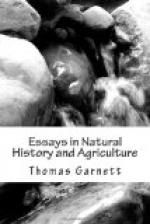As it is some years since I acquired this information, or at least a part of it, I felt afraid of giving it incorrectly; and I therefore addressed a letter to a friend living on the banks of the Wharfe, requesting him to send me all the information in his possession on this subject, that derived from his own observations, as well as that collected from others. He has since the above was written sent me the following reply:—“I have seen Robinson (one of the best anglers and fly makers between Cornwall and Caithness), and have had some conversation with him on the subject of Salmon, &c. He is of opinion that the spawn of the Salmon remains five months in the gravel before hatching; he examined the spawn in April, and found the young fry alive in the eggs, and Ingham, another angler, took some home and kept one of the Smolts two or three months. I have subsequently seen Ingham, and he has given me the same account. All the fishermen here are of opinion that the female Smolts remain one year, and the males two years, before they go down to the sea. The Bramblings are supposed to be Smolts which remain a year longer than the usual time; they are few in number, and are generally taken with the May fly. I have no doubt that the above opinions are correct, for we have now three distinct sizes of Smolts in the river exclusive of Bramblings, the largest of which are nearly four ounces in weight, and are all males, as they contain milt in October and November. The next are the females of the present year: I have had one since the receipt of your letter, which weighed half an ounce and measured five inches in length; this was a real blue Smolt; the third are the males of the same age, and are much smaller; these are occasionally taken with the worm, and will rise at the fly all the next summer.”




